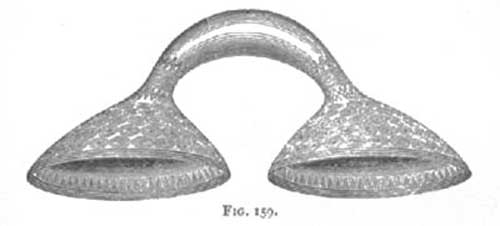The Bunne and the Bunne-do-at in Ancient Ireland
From A Smaller Social History of Ancient Ireland 1906
« previous page | contents | start of chapter | next page »
CHAPTER XVIII....continued
The Bunne and the Bunne-do-at.—There is a class of gold objects in the National Museum, very numerous—much more numerous than any other gold articles—and of various shapes and sizes, but all agreeing in two points of similarity:—open rings with ats or buttons at the two ends, of which figs. 154, 155, and 156 represent typical examples. These are what are called in the old records by the name Bunne-do-at, in which bunne (or buinne) means 'a ring,' and do 'two'.—Bunne-do-at, a ring with two ats, terminal knobs, or buttons. The designation Bunne-do-at for these rings is exactly similar to Muince-do-at for the neck crescents, and applied for the same reason.
FIGS. 157 & 158. Two specimens of the very small gold Bunne do at: full size originals in National Museum (From Wilde's Catalogue).
There are in the Museum about 150 Specimens of the Bunne-do at: they are now commonly called by the name "Fibula." They are of various shapes, as shown in the figures; and are of all sizes, from the diminutive specimens here shown in their natural size to the great bunne-do-at represented in fig. 159, the largest known to exist.
The Bunne-do-at was used as a personal ornament, and also as a mark of affluence—like many valuable articles of the present day—the size and value of course depending on the rank and means of the wearer. These articles were sometimes worn in pairs, one on each breast, and sometimes singly, on one breast: suspended from buttons like that shown at page 392, fig. 122. In one of the old tales certain persons are described as wearing Bunne-do-ats each of thirty ungas or ounces of gold (equal 22 1/2 oz. Troy). There is not necessarily any exaggeration in this statement, inasmuch as the Trinity College bunne-do-at figured here is much heavier, weighing 33 Troy ounces.
FIG. 159. Solid gold Bunne-do-at. Now in the Museum of Trinity College, Dublin: 33 oz. So far as is known the heaviest of its kind in existence. (From Wilde's Catalogue).


